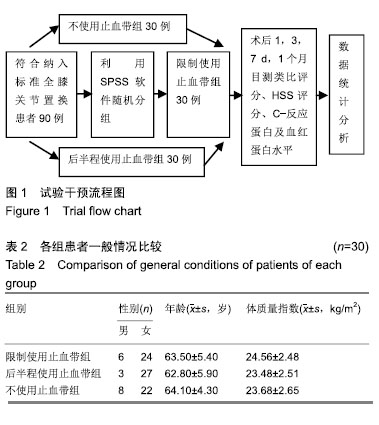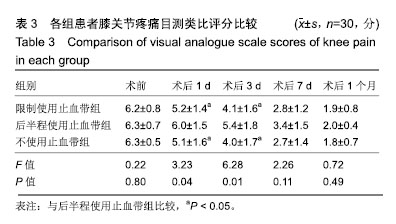| [1]Tiwari MK, Vaishya R, Agarwal AK. Tourniquet during total knee arthroplasty: a review. Apollo Med. 2017;14(1):8-11.[2]Mutlu S, Guler O, Mutlu H. Tourniquet use during total knee arthroplasty does not offer significant benefit: a retrospective cohort study. Int J Surg. 2015;18:123-127.[3]Olivecrona C, Lapidus LJ, Benson L. Tourniquet time affects postoperative complications after knee arthroplasty. Int Orthop. 2013;37(5):827-832.[4]Li B, Wen Y, Wu H. The effect of tourniquet use on hidden blood loss in total knee arthroplasty. Int Orthop. 2009;33(5):1263-1268.[5]杨建平,蒋涛,吕正祥.止血带优化对全膝关节置换术快速康复的影响[J].中国矫形外科杂志,2018,26(1):33-37.[6]Rasmussen LE, Holm HA, Kristensen PW. Tourniquet time in total knee arthroplasty. Knee. 2018;25(2):306-313.[7]中华医学会骨科学分会关节外科学组.骨关节炎诊疗指南(2018年版)[J].中华骨科杂志,2018,38(12):705-715.[8]赵学千,贾育松,孙旗,等.关节镜清理联合术后针刺与鸡尾酒疗法治疗膝骨关节炎[J].中华关节外科杂志(电子版),2018,12(5):681-686.[9]Touzopoulos P, Ververidis A, Mpogiatzis C. The use of tourniquet may influence the cement mantle thickness under the tibial implant during total knee arthroplasty. Eur J Orthop Surg Traum, 2019. DOI:10.1007/s00590-019-02369-8.[10]裴福兴.加速康复外科是现代骨外科发展的趋势[J].中国骨与关节杂志,2017,6(12):881-882.[11]王宏庆,刘祖耀,李珂,等.加速康复外科理念指导下单髁关节置换术后疼痛的相关因素分析[J].临床合理用药杂志,2017,10(29): 134-135.[12]谢小伟,岳辰,康鹏德,等.加速康复模式下初次全膝关节置换术后急性疼痛的相关因素分析[J].中华骨与关节外科杂志,2016,9(6): 489-492.[13]Drysch M, Wallner C, Schmidt SV. An optimized low-pressure tourniquet murine hind limb ischemia reperfusion model: Inducing acute ischemia reperfusion injury in C57BL/6 wild type mice. PLoS One. 2019;14(1):e210961.[14]Yu F, Jin J, Zhijian S. The limited use of a tourniquet during total knee arthroplasty: a randomized controlled trial. Knee. 2014; 21(6):1263-1268.[15]Yavarikia A, Amjad GG, Davoudpour K. The influence of tourniquet use and timing of its release on blood loss in total knee arthroplasty. Pak J Biol Sci. 2010;13(5):249. [16]Farhang B, Lesiak AC, Ianno DJ. Venous pressure during intravenous regional anesthesia: implications for setting tourniquet pressure. J Anaesthesiol Clin Pharmacol. 2018;34(4): 507-512.[17]Alcelik I, Pollock RD, Sukeik MA. Comparison of outcomes with and without a tourniquet in total knee arthroplasty: a systematic review and meta-analysis of randomized controlled trials. J Arthroplasty. 2012;27(3):331-340.[18]Hernandez AJ, Almeida AMD, Fávaro E. The influence of tourniquet use and operative time on the incidence of deep vein thrombosis in total knee arthroplasty. Clinics. 2012;67(9): 1053-1057.[19]王刚,曹晓瑞,陈晓勇.膝关节置换术中止血带的使用对术后加速康复的影响[J].中华骨与关节外科杂志,2017,10(1):27-32. [20]Wang K, Ni S, Li Z. The effects of tourniquet use in total knee arthroplasty: a randomized, controlled trial. Knee Surg Sports Trauma Arthroscopy. 2016;25(9):1-9.[21]Harsten A, Bandholm T, Kehlet H. Tourniquet versus no tourniquet on knee-extension strength early after fast-track total knee arthroplasty; a randomized controlled trial. Knee. 2015;22(2): 126-130.[22]Yan C, Chan P, Fu C. Effect of tourniquet use on blood loss and post-operative function in total knee arthroplasty. Osteoarthritis Cartilage. 2016;24(1):S518.[23]Koehler SM, Fields A, Noori N. Safety of tourniquet use in total knee arthroplasty in patients with radiographic evidence of vascular calcifications. Am J Orthop. 2015;44(9):E308-E316.[24]刘佩佩,高巍,周小红,等.帕瑞昔布钠联合地佐辛超前镇痛对下肢骨折手术术后镇痛和应激反应的影响[J].重庆医学, 2019,48(3): 489-491.[25]李敏清,张广清.术前功能锻炼对全膝关节置换患者术后康复效果影响的Meta分析[J].中国老年学杂志,2018,38(15):3676-3679.[26]Mayer C, Franz A, Harmsen JF. Soft-tissue damage during total knee arthroplasty: Focus on tourniquet-induced metabolic and ionic muscle impairment. J Orthop. 2017;14(3):347-353.[27]李伟,夏仁云.止血带疼痛机制[J].中国矫形外科杂志,2000,7(1): 60-62.[28]姜路,赵延涛,姜侃,等.老年肥胖患者TKA术前CRP与术后膝关节功能恢复的相关性分析[J].中国骨与关节损伤杂志,2019,34(1):21-24.[29]赵洪顺,阿尖措,高顺红,等.全髋关节置换局部应用氨甲环酸术中术后失血及白细胞介素6和C-反应蛋白的变化[J].中国组织工程研究, 2019,23(4):493-498.[30]张立,苏伟,赵劲民.股骨近端锁定加压钢板治疗老年股骨转子间骨折围手术期出血的危险因素[J].南方医科大学学报,2015,35(12): 1797-1801. |
.jpg)



.jpg)
.jpg)